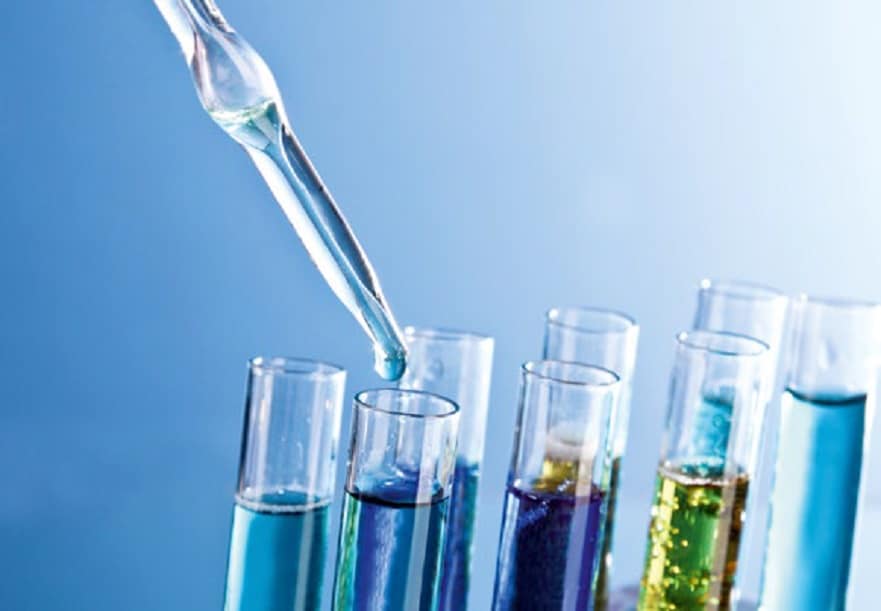REACH and Swiss chemicals legislation
With the REACH Regulation, the EU Parliament aims to achieve optimum safety for humans and the environment in the manufacture and use of chemicals. Manufacturers and importers of chemicals in the EEA are required to identify, observe and correctly communicate the inherent hazard properties of the substances and the risks involved in their use.

The term "regulation" has a different meaning in the EU than in Switzerland. In the EU, a regulation is a law. A Swiss ordinance, on the other hand, is subject to a law, just as the Chemicals Ordinance is subject to the Chemicals Act.
The REACH and CLP (Classification, Labelling and Packaging) Regulations, together with the Biocidal Products Regulation, are therefore the EU's chemicals legislation. They cover the main areas of competence, which roughly correspond to those of the Swiss Chemicals Act. They are valid for all states of the EEA as a law in the wording. For trade policy reasons
Switzerland adopts many of the requirements of the REACH Regulation.
Switzerland has adopted many of the requirements and further developments of the REACH Regulation and the CLP Regulation. However, it is not to be expected that Switzerland will fully adopt the requirements of the REACH Regulation in the next few years, because this would require amendments to our Chemicals Act. For this reason, only the more flexibly amendable Swiss ordinances to the Chemicals Act will be continuously adapted to the rapidly developing European chemicals legislation. However, our Chemicals Act, which remains unchanged, sets limits here.
The main elements/requirements of REACH:
(the terms in quotation marks below are Google search words to find the corresponding texts on the ECHA website).
- Register: Within the framework of the Substance Directive of the then EC, the obligation to determine the hazard potential of new substances coming onto the market was introduced in 1981. As a result of these investigations, a comprehensive dossier containing toxicity data, ecotoxicity data and data on physical properties was required. The submission of this dossier was referred to as notification of the substance. Substances that were already on the market in 1981 were exempted. About 100 000 substances were designated as existing substances. Under REACH, the term "register" is now used instead of "notify".
The obligation to register no longer applies only to substances newly placed on the market, but to all substances manufactured in quantities of more than 1000 kg per year by a manufacturer in the EEA or imported into the EEA by an importer. Each of these manufacturers or importers is obliged to register.
- "Phase-in substances" pre-register: Because the preparation and implementation of the registration of existing substances is an enormous task, a few years were allowed for this, namely until 31 May 2018. The companies concerned were able to pre-register the existing substances they produced or imported with the European Chemicals Agency (ECHA) by means of a simple online notification of the substance identity until 1 December 2008. Since 1981, however, additional substances have been added as existing substances, partly because the relevant definition of what constitutes a substance has changed, and partly because additional "existing substances" from the countries newly admitted to the EC or the EU after 1981 must also be taken into account. In order to clarify which existing substances are meant under REACH, the term "phase-in substances" has been introduced for all these "existing substances". "Existing" substances which are not recognised as phase-in substances may only be manufactured or imported in the EEA in quantities of more than 1000 kg per year if their registration has been completed.
- Use Restrictions: Restrictions on the use of substances already existed under the previous EC Substances Directive. These have been transferred to Annex XVII of the REACH Regulation and have since been supplemented by more recent entries. The chemicals listed in Annex XVII may only be manufactured, imported, placed on the market or used if the restriction conditions specified in Annex XVII are met. These conditions normally relate to specific non-permitted uses, types of use or prescribed protective measures and/or an excluded user group (e.g. the general public). All uses of a substance listed in Annex XVII that are not explicitly restricted are permitted. Since 2009, Annex XVII of the original REACH Regulation on restrictions of use is no longer applicable, but the Annex of the amending Regulation (EC) No 552/2009, supplemented by further amending Regulations published later.
- Identified uses of substances: For each substance, its so-called identified uses have to be indicated during registration. Only if a certain use has been named (= identified) in the registration of a substance, this substance may be used for it in the EEA. The identified uses must be listed in the manufacturer's safety data sheet. Uses of substances that are not listed in their safety data sheet are only allowed in the EEA if the downstream user registers these uses himself with ECHA. The system of identified uses means that chemical substances may only be used in the EEA for applications that are explicitly stated as identified uses in the safety data sheet. In addition, the safety and protective measures required in the safety data sheet must be applied.
Substances of very high concern:
Substances of Very High Concern (SVHC) are substances that meet the selection criteria of REACH Article 57 and have been identified according to Article 59. Such substances are listed in the so-called "candidate list". These can be CMR substances of categories 1A, 1B and 2 (carcinogenic, mutagenic and/or toxic for reproduction), PBT substances and vPvB substances, as well as substances that affect the endocrine system (the organs that, for example, release hormones into the bloodstream). In addition, there may be substances that have similar properties of concern for other reasons. The current version of the candidate list can be found on the ECHA website. If a substance is placed on the candidate list, it is to be expected that the authorities will take a closer look at it and decide on one or other restriction of use.
Substances of potential concern:
Over the next few years, the EU Chemicals Agency (ECHA) intends to clarify which additional substances of potential concern are to be added to the candidate list by 2020. The procedure envisaged for this is described on the ECHA website under "Substances of potential concern". Within the framework of the so-called "SVHC Roadmap to 2020", four working groups will evaluate possible candidates for the candidate list. Individual NGOs also publish lists of substances with properties of concern. Among them, the so-called SIN list ("Substitute It Now") of the Swedish NGO "Chemsec: The International Chemical Secretariat" with currently 830 "substances of concern" should be noted.
PBT and vPvB substances:
PBT substances have PBT properties, i.e. they are persistent (poorly biodegradable), bioaccumulative and toxic. The vPvB substances are very persistent and very bioaccumulative. The criteria according to which substances are to be tested and classified for PBT or vPvB properties are described in Annex XIII of the REACH Regulation. Substances with such properties are also considered to be of very high concern.
Without an agreement with the EU, full adoption of REACH is not up for discussion.
- Substances subject to authorisation: For substances on the candidate list with a particularly high estimated damage potential, an authorisation requirement was introduced under REACH. The candidate list is called this because the substances subject to authorisation are selected from this list in a complex procedure. The current list of substances subject to authorisation can be found on the ECHA website under "Authorisation List". Each substance has a "latest application date", after which it is no longer possible to apply for authorisation, and a "sunset date", after which the substance in question may no longer be manufactured or imported into the EEA without a valid authorisation. If you wish to continue using such a substance after the sunset date, you must apply for an authorisation for the intended use in good time. An authorisation is only valid in the EEA for the substance of the manufacturer/importer who applied for the authorisation. The customers of the authorisation holder, i.e. its "downstream users", must notify their use of the authorised substance to ECHA. ECHA enters them in a user register and gives them a number. This authorisation number must appear on the label of the product. Unauthorised uses of substances subject to authorisation are prohibited in the EEA.
How does this apply in Switzerland?
- List of Candidates: In Switzerland, the EU candidate list was incorporated into the Chemicals Ordinance as Annex 7, but not all the associated due diligence obligations. In Switzerland, too, the purchasers of articles (called "articles" in our country) must be informed immediately if it becomes known that they contain a candidate-listed substance in a concentration greater than 0.1 %.
- Mitigated licensing requirement: With the update of the Chemicals Risk Reduction Ordinance of 2012 (in Annex 1.17), Switzerland has also introduced an authorisation requirement for substances subject to authorisation in the EEA. Authorisations granted in the EEA are recognised by Switzerland. However, the Swiss implementing provisions on the authorisation requirement are greatly weakened. Whereas in the EEA an authorisation is only valid for the applicant and its customers, in Switzerland any user of an authorised use can benefit from it.
- Use Restrictions: Switzerland has also had restrictions on use for years. These are also regulated by the Chemicals Risk Reduction Ordinance (ChemRRV). Restrictions on substances newly included in Annex XVII of the REACH Regulation are periodically incorporated into the ChemRRV.
- Further Swiss adaptations to REACH and CLP: The other Swiss adaptations to the EU chemicals legislation mainly concern the regulations on the classification of substances and mixtures, as well as their labelling and packaging, as laid down in the CLP Regulation. These have been adopted practically 1:1. The so-called "harmonised classifications" of substances prescribed in Annex VI of the CLP Regulation are also binding for us.
In addition, the provisions on the preparation of safety data sheets laid down in Regulation (EU) No 453/2010 have been adopted. Likewise, the obligation to include exposure scenarios for substances with more than 10 t turnover per year as an annex in the safety data sheet.
- Indirect influences on the Swiss application of the law: The obligation to exercise due diligence in the handling of chemicals laid down in Article 7 of our Chemicals Ordinance presupposes compliance with the applicable state of the art. The fact that Swiss authorities or courts define consequences of the requirements of the REACH Regulation as state of the art means that these must therefore also be complied with in Switzerland, even if they have not been explicitly incorporated into Swiss law. This may concern, for example, costly precautionary and protective measures that have become state of the art in the EEA as a consequence of the REACH regulations.









